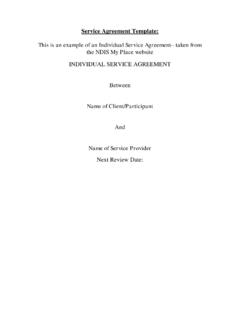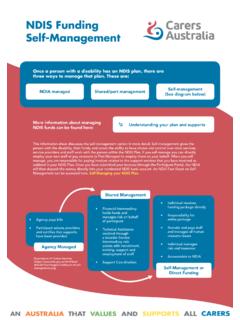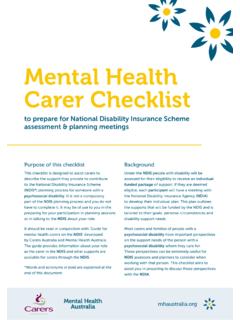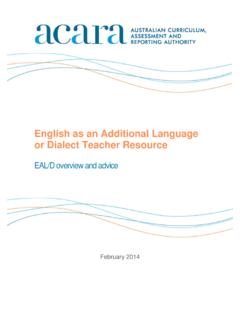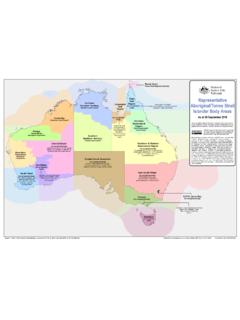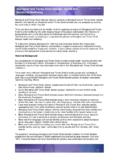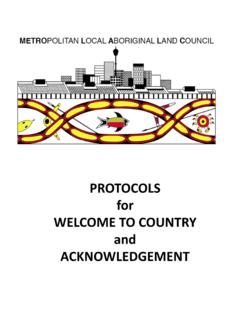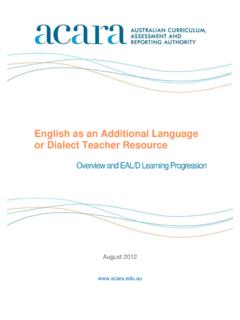Transcription of Working with Aboriginal people and communities …
1 Produced byAboriginal Services Branch in consultation with the Aboriginal Reference Group NSW Department of Community Services4-6 Cavill AvenueAshfield NSW 2131 Phone (02) 9716 2222 February 2009 ISBN 1 74190 097 2 number of NSW Department of Community Service (Community Services) regions as well as several other government agencies have created their own practice guides for Working with Aboriginal people and communities . In developing this practice resource, we have combined the best elements of existing practices to develop a resource that provides a consistent approach to Working with Aboriginal people and The information and practice tips contained in this document are generalisations and do not reflect the opinions of all Aboriginal people and communities in NSW.
2 There may be exceptions to the information Aboriginal people are the original inhabitants of NSW; and as the NSW Government only has a specific charter of service to the people of NSW, this document refers only to Aboriginal people . References to Torres Strait Islander people will be specifically stated where relevant. It is important to remember that Aboriginal and Torres Strait Islander cultures are very different, with their own unique histories, beliefs and values. It is respectful to recognise their separate identities. Community Services recognise that Torres Strait Islander people are among the First Nations of Australia and represent a part of our client and staff base.
3 The Department s Aboriginal programs and services are available, without question, to Torres Strait Islander ONE: GENERAL INFORMATIONWhat is the practice resource and why do we need it? 2 Historical overview 3 History of mistrust of welfare based agencies 3 State and national apologies 3 Over-representation of Aboriginal people 5 Sensitive issues 5 Grief and loss (Sorry Business) 6 Use of the terms Indigenous , Aboriginal and Torres Strait Islander 7 Aboriginal and Torres Strait Islander flags 9 Aboriginal language group names and nations 10 Aboriginal concept of family and community 13 Acknowledgement of land and original custodians and Welcome to Country 14 Men s and Women s Business 16 Communication 18 Respect and sensitivity 18 Use of appropriate language 21 Communication techniques 25 Building rapport 26 Cultural bias 27 Participation 28 CONTENTSSECTION TWO.
4 Aboriginal COMMUNITY CONSULTATIONE ffective consultation with Aboriginal organisations and communities 30 Working with Aboriginal organisations 32 Understanding community structures 33 SECTION THREE: RESOURCESC alendar of significant cultural events 36 Important things to remember 40 References 4212 What is the practice resource and why do we need it?This practice resource Working with Aboriginal people and communities is a guide for all Community Services and relevant non-government organisation (NGO) staff, particularly field staff. It has been developed to improve service delivery to Aboriginal people by providing staff with key facts, and information relevant to Working with Aboriginal communities in NSW.
5 This resource will help us become more culturally aware and responsive to the needs of Aboriginal people and communities . Working with Aboriginal people and communities provides important information to improve our knowledge and understanding of the diverse cultural dynamics that exist within Aboriginal families and communities . It suggests some engagement and communication strategies that will improve the way we work with and relate to Aboriginal people . Staff in Community Services and NGOs may find it difficult to build open and trusting relationships with Aboriginal people and vice versa. This can often be attributed to a lack of cultural understanding or a lack of awareness of effective practice techniques.
6 This resource will help staff to break down these barriers by offering practical advice and solutions. Many cultural and historical factors need to be acknowledged by anyone who works closely with Aboriginal people . Having a greater understanding of this background, puts us in a better position to appreciate both the current impacts these factors have on communities and how we can work with Aboriginal people in the culture and communities are diverse and there are many different nations, tribes and groups living in NSW. In view of this a one size fits all approach will not work and we need to tailor our ways of Working and communicating to meet the needs of the individuals and communities overviewHistory of mistrust of welfare based agenciesHistorically the words protection and intervention have not been associated with positive outcomes for Aboriginal people , even where the actions of individuals offering these services may have been well intended.
7 There is an understandable mistrust of people who offer services based on these concepts. Some reasons for this mistrust stem from European colonisation and the subsequent forced removal of Aboriginal children from their families and communities , resulting in the Stolen Generation. Removing children from their families was official government policy in Australia until 1969. Taking children from their families was one of the most devastating practices of white settlement and for many Aboriginal people the impact of this practice is still felt today. There are a number of other underlying social issues faced by Aboriginal families that impact on the issue of mistrust such as power differences, lack of representative structures and a lack of Aboriginal people in influential positions in government.
8 Having said this, NSW Government organisations and NGOs are putting policies and programs in place that are committed to acknowledging and attempting to change these perceptions. However, this is something that is going to take time. Government and non-government agencies are moving towards Working in more coordinated and collaborative ways with Aboriginal organisations and communities to develop a range of strategies, programs and initiatives that better meet their needs. State and national apologiesIn 1995, the Commonwealth Attorney General established a National Inquiry into the Separation of Aboriginal and Torres Strait Islander Children from their Families, to be conducted by the Human Rights and Equal Opportunity Commission (HREOC).
9 The Inquiry report, Bringing them home, was tabled in the Commonwealth Parliament on 26 May 1997. On 18 June 1997, former NSW Premier the Hon. Bob Carr, issued a formal apology in response to Bringing them home. Premier Carr moved that NSW apologises unreservedly to the Aboriginal people of Australia for the systematic separation of generations of Aboriginal children from their parents, families and communities and acknowledges and regrets Parliament s role in enacting laws and endorsing policies of successive governments whereby profound grief and loss have been inflicted upon Aboriginal Australians .2On 13 February 2008, history was made when newly elected Prime Minister Kevin Rudd issued a formal apology to all Aboriginal and Torres Strait Islander peoples on behalf of current and successive Commonwealth Government/s: 4 We apologise for the laws and policies of successive Parliaments and governments that have inflicted profound grief, suffering and loss on these our fellow Australians.
10 We apologise especially for the removal of Aboriginal and Torres Strait Islander children from their families, their communities and their country. For the pain, suffering and hurt of these Stolen Generations, their descendants and for their families left behind, we say sorry. To the mothers and the fathers, the brothers and the sisters, for the breaking up of families and communities , we say sorry. And for the indignity and degradation thus inflicted on a proud people and a proud culture, we say sorry. We the Parliament of Australia respectfully request that this apology be received in the spirit in which it is offered as part of the healing of the nation. 3 KEVIN RUDD S APOLOGY TO THE STOLEN GENERATIONS5 Over-representation of Aboriginal peopleAboriginal children and young people make up around 4 per cent of all children and young people in NSW, yet they represent more than 29% of all children and young people in out-of-home care (OOHC).
